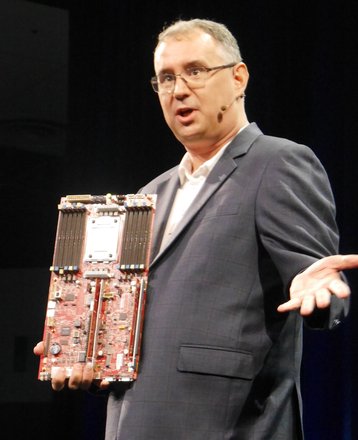One issue people have with standards and agreements: they fear that they will do away with variety in the name of efficiency, and make it hard for new ideas and technologies to flourish. If the specifications are set in stone, then nothing can change, right?
Well, not exactly. The other view is that standardization clears away wasted effort. Well understood technology can be simplified and delivered in standard ways without the willful waste caused by the artificial differentiation of proprietary systems. This creates a better platform on which everyone can differentiate.
Variety if you want it
In fact, both of these things can be true, if you want them. At the Open Compute Project Summit in Santa Clara earlier this year, we saw how Facebook is using OCP standards to create a limited set of designs, while Microsoft is creating a platform where varieties of servers and storage can change more rapidly than ever.
OCP was set up based on the way Facebook (like other webscale players) trims its hardware budget by specifying simple, no-frills servers that hardware makers build. OCP extends this to other equipment, and opens the buyers’ club up to other players, by sharing those specifications.
These specifications become sort of “standards”, though they don’t have formal acceptance from standards bodies. They aren’t mandated, and they can be redesigned at will.
Within OCP, Facebook can meet its needs for monolithic technology: a design that can be rolled out to all its data centers over a period of years. Facebook’s Vijay Rao showed some great server designs, and told the OCP meeting that his colleagues can have any server they like - “as long as it’s one of these.”
In the same portmanteau keynote, Microsoft’s Kushagra Vaid set up almost the opposite. Last year, he launched Project Olympus at the DCD Zettastructure event in London. Now, it’s clear what that is doing. By sharing the actual process of creating server designs, Microsoft is making it possible for multiple options to get developed at the same time.
Olympus servers will include ARM-based systems alongside Intel servers, and they are coming fast. The new ARM processors from Cavium and Qualcomm aren’t available, but these just-in-time motherboards will pop out of the Olympus process in time for freshly-minted ARM processors to land on them.
Why the variety? Microsoft isn’t selling a single application, but a cloud environment where applications can reside, and more variety there means more customers can be served,
Microsoft won’t be selling the hardware to customers, but using them to implement Azure services. The company sees that cloud services based on different technologies will be a way to differentiate itself from other providers.
Microsoft isn’t selling a single application, but a cloud environment where applications can reside, and more variety there means more customers can be served
Some have reported this as if Microsoft is actually replacing the Intel chips in its servers with ARM-based processors (or are the headlines just misleading?). In fact, this is just an option for customers, alongside Intel, albeit one which Microsoft itself says could handle 60 percent of data center tasks very well.
Of course, when the chips are available, these shared motherboard designs can be quickly used by other people can make commercial ARM-based motherboards. That will be a boon for Qualcomm and Cavium. It looks like the most credible ARM-based approach to data centers for years - and it won’t hurt Microsoft to help other people push it along.
Technically, OCP isn’t a standards body at all. But its processes are simultaneously allowing one big player to limit unwanted variety, and another to enable all the variety its customers want.
A version of this article appeared on Green Data Center News



